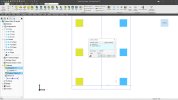I've made a lot of progress learning Alibre but have several things that still seem to frustrate and cost me a lot of time. I'd sure like to figure out what it is I'm doing to avoid such. Here it goes.
1. I gathered that once a sketch is used for a modeling function, it is no longer available for any other function. For example loftfrom a sketch in one direction and extrude in the other is not allowed. Just confirming, Is that correct? I find myself having to duplicate sketches in the same/identical plane and position which seems like poor practice laying them on top of one another.
2. Once a sketch has been used for a solid such as extrusion, sweep, loft, etc, Is it forever associated with that function? Even if that feature is deleted? I ask, because say I use a sketch to extrude a solid, then I decide to remove/delete that extrusion and it is the last feature in the design tree. If I try to use that sketch for another extrusion or sweep or whatever, I get an error that says I am requesting the use of an item that has been deleted, but the skecthes status in the DE does not say that and displays without error in the DE. If I delete that sketch and create an identical new sketch for use, that solves the problem, but takes a lot time.
3. Somewhat similarly, if I use a a solid in a linear pattern, and I try to use that solid in any other way afterward, sometimes even just modifying the linear pattern or trying to mirror the linear pattern, I get an error that says the target is no longer available. So instead of mirroring an array of patterned solids, I have to create a new sketch in the mirrored position, create the solid, and pattern for multiples. Seems like similar to the above, once that solid got used in a pattern, it became forever unavailable for anything else. Is that normal?
So in both those examples above, it's like the sketch or solid is forever associated with the function which it was previously used andthereafter is rendered useless and must be recreated. Is that normal or just something I'm doing (or not doing)? I mIght be able to post an example if the questions are not clear.
Best,
Kelly
1. I gathered that once a sketch is used for a modeling function, it is no longer available for any other function. For example loftfrom a sketch in one direction and extrude in the other is not allowed. Just confirming, Is that correct? I find myself having to duplicate sketches in the same/identical plane and position which seems like poor practice laying them on top of one another.
2. Once a sketch has been used for a solid such as extrusion, sweep, loft, etc, Is it forever associated with that function? Even if that feature is deleted? I ask, because say I use a sketch to extrude a solid, then I decide to remove/delete that extrusion and it is the last feature in the design tree. If I try to use that sketch for another extrusion or sweep or whatever, I get an error that says I am requesting the use of an item that has been deleted, but the skecthes status in the DE does not say that and displays without error in the DE. If I delete that sketch and create an identical new sketch for use, that solves the problem, but takes a lot time.
3. Somewhat similarly, if I use a a solid in a linear pattern, and I try to use that solid in any other way afterward, sometimes even just modifying the linear pattern or trying to mirror the linear pattern, I get an error that says the target is no longer available. So instead of mirroring an array of patterned solids, I have to create a new sketch in the mirrored position, create the solid, and pattern for multiples. Seems like similar to the above, once that solid got used in a pattern, it became forever unavailable for anything else. Is that normal?
So in both those examples above, it's like the sketch or solid is forever associated with the function which it was previously used andthereafter is rendered useless and must be recreated. Is that normal or just something I'm doing (or not doing)? I mIght be able to post an example if the questions are not clear.
Best,
Kelly

